This is a guest post by Sheryl Davis. Sheryl is a digital marketer at Glew, an ecommerce analytics software provider, where she focuses on helping online stores understand and act on their data.
Are you frustrated with your conversion rate even when traffic to your storefront is up? Are you asking yourself why more visitors aren’t buying your products? You aren’t alone. Many stores struggle with converting their traffic to buying customers.
Let’s look at five specific places in Google Analytics that hold clues to help you solve this problem.
Clue #1: Bounce Rate
Click on Google Analytics > Behavior > Site Content > All Pages.
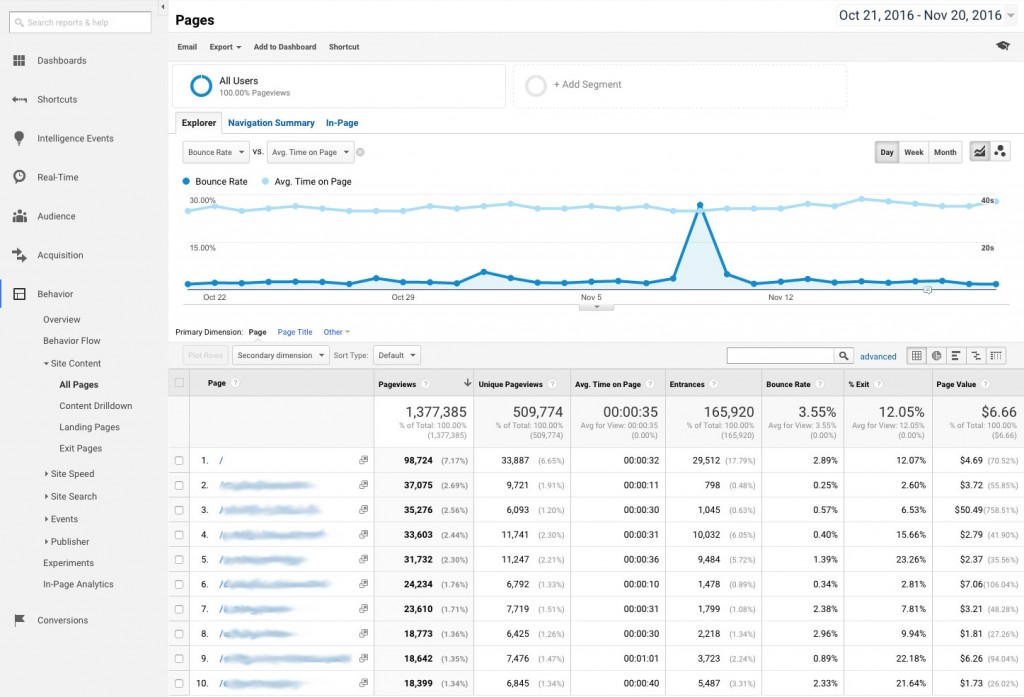
What is Bounce Rate?
Bounce Rate is the percentage of sessions during which a browser left a website from the entrance page without going to a second page. Having a high Bounce Rate can be an indicator of pages that need additional work. Lowering your Bounce Rate increases your chance of successful conversions.
Refocus your content
Look at pages that have a high Bounce Rate as well as a low Average Time on Site. Why are visitors leaving quickly and often? Are they looking for something else? Is there not enough content on the page to get them to stick around? Product pages can often be the worst offenders of a high Bounce Rate. Add a link to a blog post that features the product, show a video of someone using the product, curate a collection of customer photos, or incorporate links to product manuals or reviews.
Encourage users to keep clicking
Browsers are lazy. Don’t assume they will do the work to look around for places to keep reading. Without cluttering up your design, drop as many avenues as you can to keep them on your site. A great way to keep browsers clicking is through the use of a sidebar. Does your company have a unique story to tell? Include a link to a page about your company’s story. Are new collections debuting soon? Link to a preview of new designs to come! And don’t forget about content that was posted months or years ago. Since blog posts can keep a long shelf life in organic search, there should always be a quick way to get to recent content.
Clue #2: New vs Returning Visitors
Click on Audience > Behavior > New vs Returning > Click on New Visitor. Filter further by adding Secondary Dimension > Source / Medium.
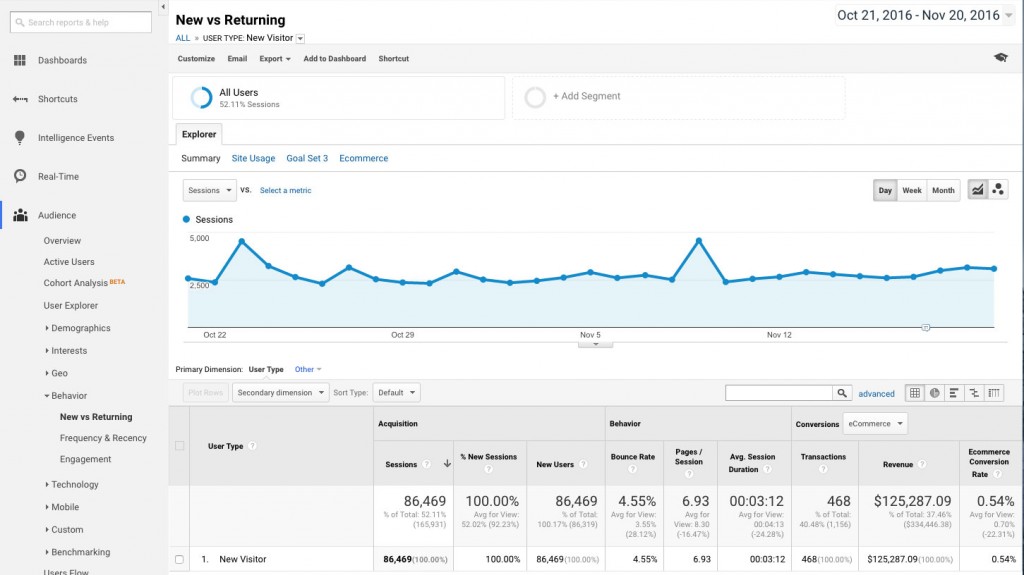
Why is this important?
This table will show a breakdown of visitor type by traffic sources. Study channels that are driving new traffic (good) but are failing to bring in traffic that is converting (bad). Remember new traffic is useless if it isn’t driving conversions.
Paid Channels
Ensure your advertisements are bringing in more revenue than is being spent on ad dollars. This feels obvious, right? It’s surprisingly easy to overlook the revenue these channels contributed and instead focus on brand awareness metrics such as followers, visits or shares.
Double check that sales from paid channels like Google Adwords, Bing Ads, AdRoll or Facebook Ads are adding to your bottom line. Running ads should increase new visitors to your site, but without sales they are draining money away. Cut out advertising from costly channels with a poor return on ad spend and instead focus on organic methods.
Organic Channels
Organic traffic is good – simple as that. Organic traffic is any traffic that comes through a non-paid channel. The most common types of organic traffic are organic searches, referral traffic or traffic derived from your social accounts.
Since this traffic is free, having more of it isn’t an issue. Instead use this table to find areas of opportunity. If visitors are finding you for the first time from an organic method, add a Call to Action on the pages they are landing on. Referral traffic that is brining in new visitors can be a great place to look for future partnership opportunities. Bloggers are constantly looking for products to promote or sponsor, so use this table to understand what is working.
Clue #3: Search Queries
Log in to Google Analytics and go to > Acquisition > AdWords > Search Queries.
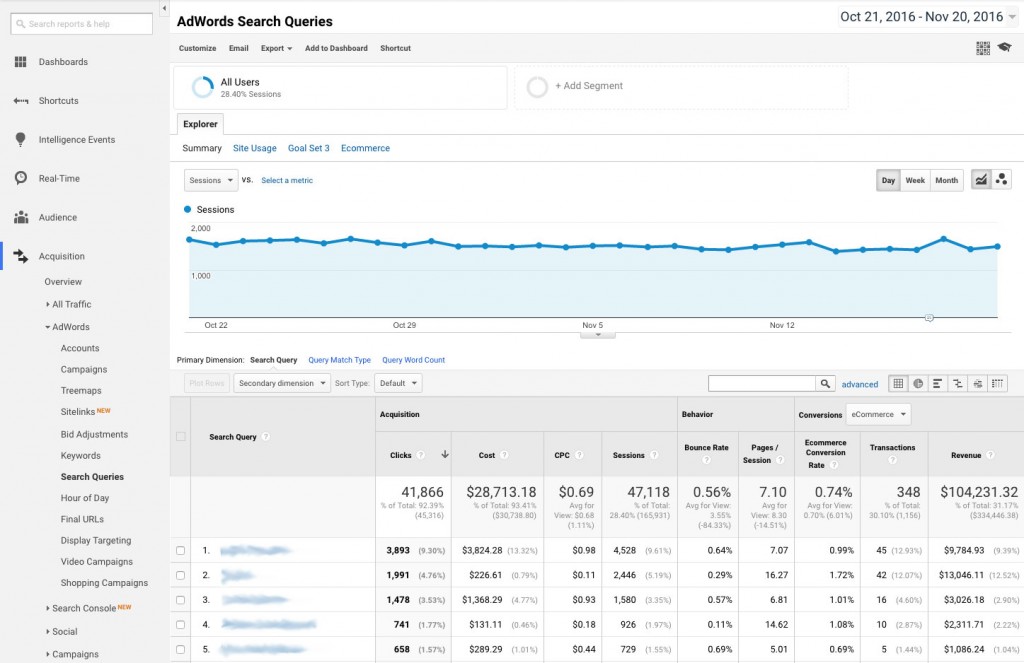
Google AdWords is a computer program. It can’t always distinguish nuances in language or differentiate between words that have multiple meanings. An easy and actionable way to lower junk traffic is to use negative keywords in Google AdWords. Negative keywords exclude unwanted traffic from people who are searching for an item unrelated to your offering.
Here is an example: Say you own a store that sells belts for men’s and women’s fashion. Negative keywords would eliminate searches for conveyer belts, seat belts, black belts, the Asteroid belt or even Belt, Montana.
Google AdWords is smart, but it won’t be accurate 100% of the time. Go through the search queries that brought traffic to your site. Take out any keywords that drove irrelevant traffic and enter those as negative keywords in Google Analytics. See a guide on how to do that here.
Clue #4: Exit Pages
Click on Acquisition > Behavior > Exit Pages.
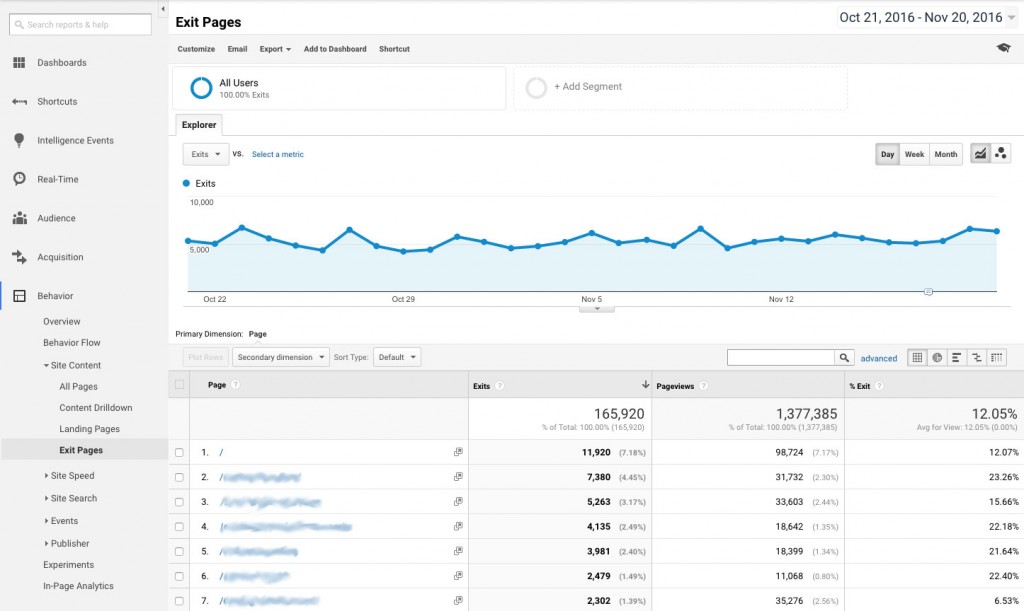
An Exit Page is the ugly stepsister to a Landing Page. It’s natural to spend more time focused on what is working rather than evaluate what isn’t working. But Exit Pages illuminate exactly where and when website visitors move on from your site empty handed.
Sort this table to see which pages have the largest amount of exiting traffic. (Most likely your homepage will be the first page, this is normal.) Similar to strategies on lowering Bounce Rate, work to build avenues for capturing visitors and keeping them engaged.
- Implement a popup with a discount code that will appear when a user starts to exit
- Provide links to webpages about your story and company
- Drive users to blog posts that feature hot products
- Show commonly purchased together items on the bottom of every product page
- Include a sidebar that offers links to upcoming releases
- Create stronger Call to Actions that heighten sense of urgency
- Ask for browsers to join your mailing list so you can sell to them at a later time
- Add a chat feature that will come up within your site to answer questions
- Use retargeting advertisements to later target browsers with the exact product they were viewing
All of these strategies work to hook browsers into sticking around and entice them with offers to convert.
Clue #5: Mobile Browsing
Click on Audience > Mobile > Overview.
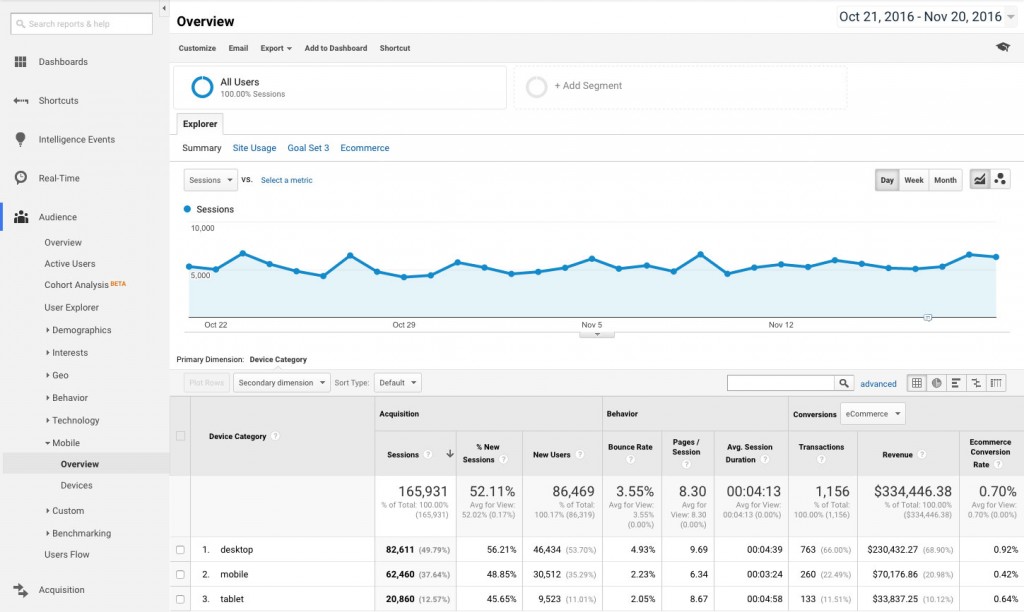
According to research done by Custora, during the 2015 holiday season, smartphones and tablets drove 30.4% of online sales.
Can you afford to lose out on 30% of shoppers? Without a responsive storefront mobile browsers will leave en masse.
Tips for Not Losing Mobile Shoppers
Troubleshoot your entire checkout process by making sure your storefront, shopping cart and payment gateways have a responsive design. This can be as simple as pulling up your iPhone, or simply dragging your browser to be as skinny as possible and going through the motions of checking out.
Make sure buttons and links are large enough that a user can click on them on a tiny screen without tapping on a different link.
Eliminate any “hover” options on your site. Since tablet and mobile phones don’t use hover technology, this simple fix could have a drastic increase in your bottom line.
Reduce image file sizes as much as possible. Google provides a powerful free tool that shows a breakdown of what is slowing down your site speed on both mobile and desktop displays.
Final Note
Google Analytics can often feel overwhelming and daunting. The most important thing is to go in with a goal in mind and look for actionable ways to use the data provided. Stay focused on your goal of increasing conversions and use these five clues to start solving problems and continue reeling in sales!
5 Clues in Google Analytics as to Why Website Visitors Aren’t Converting 4.50/5 (90.00%) 2 votes
Related Posts


5 Clues in Google Analytics as to Why Website Visitors Aren’t Converting
This is a guest post by Sheryl Davis. Sheryl is a digital marketer at Glew, an ecommerce analytics software provider, where she focuses on helping online stores understand and act on their data.
Are you frustrated with your conversion rate even when traffic to your storefront is up? Are you asking yourself why more visitors aren’t buying your products? You aren’t alone. Many stores struggle with converting their traffic to buying customers.
Let’s look at five specific places in Google Analytics that hold clues to help you solve this problem.
Clue #1: Bounce Rate
Click on Google Analytics > Behavior > Site Content > All Pages.
What is Bounce Rate?
Bounce Rate is the percentage of sessions during which a browser left a website from the entrance page without going to a second page. Having a high Bounce Rate can be an indicator of pages that need additional work. Lowering your Bounce Rate increases your chance of successful conversions.
Refocus your content
Look at pages that have a high Bounce Rate as well as a low Average Time on Site. Why are visitors leaving quickly and often? Are they looking for something else? Is there not enough content on the page to get them to stick around? Product pages can often be the worst offenders of a high Bounce Rate. Add a link to a blog post that features the product, show a video of someone using the product, curate a collection of customer photos, or incorporate links to product manuals or reviews.
Encourage users to keep clicking
Browsers are lazy. Don’t assume they will do the work to look around for places to keep reading. Without cluttering up your design, drop as many avenues as you can to keep them on your site. A great way to keep browsers clicking is through the use of a sidebar. Does your company have a unique story to tell? Include a link to a page about your company’s story. Are new collections debuting soon? Link to a preview of new designs to come! And don’t forget about content that was posted months or years ago. Since blog posts can keep a long shelf life in organic search, there should always be a quick way to get to recent content.
Clue #2: New vs Returning Visitors
Click on Audience > Behavior > New vs Returning > Click on New Visitor. Filter further by adding Secondary Dimension > Source / Medium.
Why is this important?
This table will show a breakdown of visitor type by traffic sources. Study channels that are driving new traffic (good) but are failing to bring in traffic that is converting (bad). Remember new traffic is useless if it isn’t driving conversions.
Paid Channels
Ensure your advertisements are bringing in more revenue than is being spent on ad dollars. This feels obvious, right? It’s surprisingly easy to overlook the revenue these channels contributed and instead focus on brand awareness metrics such as followers, visits or shares.
Double check that sales from paid channels like Google Adwords, Bing Ads, AdRoll or Facebook Ads are adding to your bottom line. Running ads should increase new visitors to your site, but without sales they are draining money away. Cut out advertising from costly channels with a poor return on ad spend and instead focus on organic methods.
Organic Channels
Organic traffic is good – simple as that. Organic traffic is any traffic that comes through a non-paid channel. The most common types of organic traffic are organic searches, referral traffic or traffic derived from your social accounts.
Since this traffic is free, having more of it isn’t an issue. Instead use this table to find areas of opportunity. If visitors are finding you for the first time from an organic method, add a Call to Action on the pages they are landing on. Referral traffic that is brining in new visitors can be a great place to look for future partnership opportunities. Bloggers are constantly looking for products to promote or sponsor, so use this table to understand what is working.
Clue #3: Search Queries
Log in to Google Analytics and go to > Acquisition > AdWords > Search Queries.
Google AdWords is a computer program. It can’t always distinguish nuances in language or differentiate between words that have multiple meanings. An easy and actionable way to lower junk traffic is to use negative keywords in Google AdWords. Negative keywords exclude unwanted traffic from people who are searching for an item unrelated to your offering.
Here is an example: Say you own a store that sells belts for men’s and women’s fashion. Negative keywords would eliminate searches for conveyer belts, seat belts, black belts, the Asteroid belt or even Belt, Montana.
Google AdWords is smart, but it won’t be accurate 100% of the time. Go through the search queries that brought traffic to your site. Take out any keywords that drove irrelevant traffic and enter those as negative keywords in Google Analytics. See a guide on how to do that here.
Clue #4: Exit Pages
Click on Acquisition > Behavior > Exit Pages.
An Exit Page is the ugly stepsister to a Landing Page. It’s natural to spend more time focused on what is working rather than evaluate what isn’t working. But Exit Pages illuminate exactly where and when website visitors move on from your site empty handed.
Sort this table to see which pages have the largest amount of exiting traffic. (Most likely your homepage will be the first page, this is normal.) Similar to strategies on lowering Bounce Rate, work to build avenues for capturing visitors and keeping them engaged.
All of these strategies work to hook browsers into sticking around and entice them with offers to convert.
Clue #5: Mobile Browsing
Click on Audience > Mobile > Overview.
According to research done by Custora, during the 2015 holiday season, smartphones and tablets drove 30.4% of online sales.
Can you afford to lose out on 30% of shoppers? Without a responsive storefront mobile browsers will leave en masse.
Tips for Not Losing Mobile Shoppers
Troubleshoot your entire checkout process by making sure your storefront, shopping cart and payment gateways have a responsive design. This can be as simple as pulling up your iPhone, or simply dragging your browser to be as skinny as possible and going through the motions of checking out.
Make sure buttons and links are large enough that a user can click on them on a tiny screen without tapping on a different link.
Eliminate any “hover” options on your site. Since tablet and mobile phones don’t use hover technology, this simple fix could have a drastic increase in your bottom line.
Reduce image file sizes as much as possible. Google provides a powerful free tool that shows a breakdown of what is slowing down your site speed on both mobile and desktop displays.
Final Note
Google Analytics can often feel overwhelming and daunting. The most important thing is to go in with a goal in mind and look for actionable ways to use the data provided. Stay focused on your goal of increasing conversions and use these five clues to start solving problems and continue reeling in sales!
Related Posts
Tags: